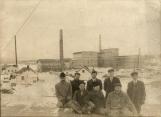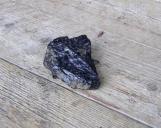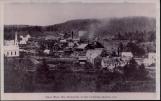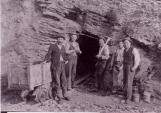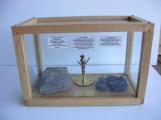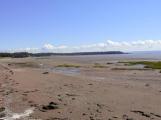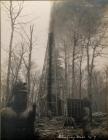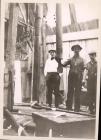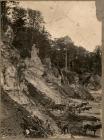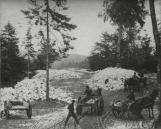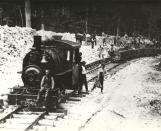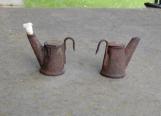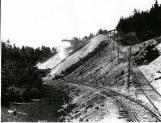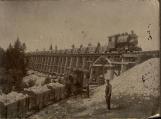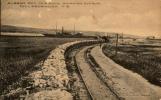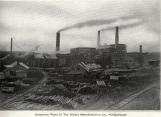

Albert County Museum
Hopewell Cape, New Brunswick
1
The Mining Industry in Albert CountyThe mining industry in Albert County has a long and interesting history. Few places in the world can boast of having such a diverse selection of mineral resources in such a small area. Within the boundaries of Albert County deposits of such minerals as gold, silver, lead, zinc, copper, manganese, gypsum, oil and gas, and natural gas have all been mined.
The most unique mineral ever harvested in Albert County was a shiny black hydrocarbon similar in appearance to coal which is found only in Albert County, hence it was given the name ĎAlbertite'.
3
Albertite was first discovered in Albert Mines in 1820 by Gould Hoar who discovered a deposit of the mineral under an uprooted tree. At first no one realized albertite's potential value as a source of fuel, because it was a new previously unknown mineral and its properties had not yet been determined. Then geologist Dr. Abram Gesner began to experiment on albertite. It was from these experiments that he first derived kerosene. The discovery of kerosene would make him world famous. Prior to the discovery of kerosene, whale oil was the most commonly used fuel in oil lamps. However, over harvesting of whales had led to an increase in whale oil prices, that combined with a high demand for whale oil, led to more research into alternative fuel sources. Kerosene provided the world with an inexpensive fuel source for oil lamps. It was easier and cheaper to produce kerosene from mined materials rather than send sailors on voyages around the world in search of whales. The process Dr. Gesner discovered for deriving kerosene from albertite was later used to produce other petroleum fuels including oil and gas.In 1850, the bursting of a sawmill dam combined with annual spring floods eroded the banks of a river in Albert Mines and revealed a huge deposit of albertite.
5
In 1852, Dr. Gesner claimed the discovery of this new mineral and petitioned the government to have the rights to mine this mineral awarded to him and his company. Another company argued that the mineral was another form of coal. Since they already owned the rights to mine coal in the area, they argued that they should be given the rights to mine this new mineral as well. The two companies would feud for years to the point of fist fights and guns being drawn at the mine entrance. Dr. Gesner lost his lawsuit but it was later shown that he was in fact correct, albertite is not a type of coal. The mineral, shiny black in appearance, is very brittle to the touch. It can be thought of almost as a form of congealed gasoline, since 57% of the mineral is combustible matter.Albertite mining in Albert Mines started in 1854 and lasted until 1884.
7
The mine was still profitable when it closed in 1884. However, the mine owners apparently believed that the mine would soon become unprofitable, even though there were still large supplies of albertite left in the ground. Captain James Blight would later open another albertite mine below Hillsborough, however, this operation only lasted for a few years. Most of the mined albertite was sent to Boston to be used to enrich illuminating gas.9
However, since Dr. Gesner could not obtain a steady supply of the mineral, because the mining rights were held by another company, albertite was not used in the production of kerosene.Other minerals mined in the area included copper and manganese.
11
There was considerable effort put into mining copper in New Ireland, Alma, and parts of Elgin. Manganese was mined from 1875 to 1877 at Waterside and from Shepody Mountain beginning in 1860. Bog manganese was harvested in Dawson Settlement from 1897 to 1900. Bog manganese is not mined but is instead harvested. Underground streams carry manganese up to the surface, the manganese is then deposited at an outlet of the stream on the surface. This manganese then forms into a bog. The manganese harvested from this bog must first be dried before it can be sold. All of the copper and manganese mining operations listed above failed largely due to mismanagement and lack of capital required to make the operations profitable. Manganese was also mined in Elgin for a short period following World War II.One of the oldest and most important materials mined in Albert County was ordinary stone. One of the earliest stories of mining in Albert County tells of Thomas Calhoun and his brother William harvesting grindstones from Grindstone Island and shipping them to the United States around 1771. Grindstones were used to grind down metal, for example, they were used to sharpen sword edges. These stones were so valuable that they were traded as currency. Many beautiful historic buildings in Boston, Halifax, and Saint John were constructed out of stone imported from the stone quarries of Albert County, such as the quarry at Mary's Point. Since many of these quarries were located near the Petitcodiac River or the Bay of Fundy it was easy to transport these heavy stone blocks by ship. Recently when a historic building in Halifax was being rebuilt new stones for the reconstruction had to be obtained from the old quarry at Mary's Point to ensure the authenticity of the building was maintained.
13
This painting depicts the stone quarry at Mary's Point, ca. 1860.15 September 2003
Harvey, New Brunswick, Canada

14
Oil shale is another mineral found in large quantities in Albert County. Oil shale a mineral similar in appearance to coal can be burned like coal or distilled. When distilled the oil shale found in Albert County produces between 20 - 45 gallons of oil per ton, which is a greater amount than the oil shale produced in Scotland. Except for oil shale mines in Scotland, oil shale has never been mined profitably because it is cheaper to drill for oil and refine that oil rather than distill oil shale. However, perhaps in the future as oil prices continue to rise the oil shale reserves of Albert County may well be used to help supply the oil demands of the world.Besides mining oil shale the more traditional method of drilling for oil has also been done in Albert County. The Stoney Creek oil fields started producing crude oil and gas in 1909.
16
Oil had been found in nearby Westmorland county in 1859, however, another well had been discovered in Pennsylvania that same year. That well supplied all the oil needed in North America. No further exploration was done in Albert County or Westmorland County because there was no increase in the demand for oil until the development of the internal combustion engine in the early twentieth century. In 1923, the production of crude oil in Albert County was 308,984 gallons, and 619,673 thousand feet of gas. By 1925, sixty-six wells had been bored in the Stoney Creek oil fields.18
The method used to drill these wells was called the "cable tool" method. This involved using a thirty-five horsepower steam engine to raise a heavy tool three feet in the air and then letting it drop onto the ground, forty times a minute. After the heavy tool was finished pulverizing the ground the tool was lifted out of the hole and the pulverized rock was then mixed with water and pulled up out of the hole by a bailer attached to another cable. Next pipe casing was sunk into the drill shaft, the diameter of the pipe casing got progressively narrower as the hole went further into the ground.21
A group of men carrying pipe casings into the oil well.19 September 1915
Stoney Creek, New Brunswick, Canada
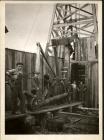
22
The oil was then pumped up from the ground through a two inch thick pipe that was lowered into the pipe casings. It could take anywhere from three months to an entire season to drill an oil well using this method. An oil and gas refinery was built at Weldon which supplied oil and gas to local area residents. The company that owned the refinery also owned two gas stations in the area and sold gasoline using the brand name MICMAC. Today, there is not much oil and gas exploration being carried out in Albert County, however, there are still a few oil wells in the area which are still producing gas. With the boom in natural gas exploration in Nova Scotia, and the recent discovery of large amounts of natural gas in the Sussex area, near Albert County, companies are beginning to consider reopening the oil and gas fields of Albert County.The most important of the minerals mined in Albert County was gypsum. By the 1930's Albert County produced eighty percent of the total output of gypsum in the Province. The gypsum mined in Albert County was considered to be some of the finest quality gypsum in the world. The Albert Manufacturing Company operated from 1854 until 1980.
23
A group of employees standing in front of the Albert Manufacturing Company Mill in Hillsborough.19 September 1912
Hillsborough, New Brunswick, Canada
